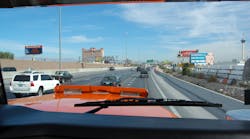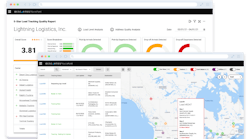An annual performance report compiled by technology provider GreenRoad indicates that monitoring systems can dramatically alter truck driver behavior – especially in regards to speeding.
The firm’s yearly Fleet Driver Performance Data Benchmark report, which offers a “snapshot” of performance based on data gleaned from 70,000 drivers worldwide, posted a 28% improvement in “Safety Scores” recorded by the company’s monitoring system between 2011 and 2012.
In the U.S., GreenRoad added that no single driving event dominated its “Safety Score” metric, as corner handling (29%), harsh braking (26%) and speeding (26%) were determined to be the most common risky or inefficient events, with excessive acceleration and lane handling each at 10%.
Yet that sharply contrasts with GreenRoad’s 2011 data, when speeding was by far the most dominate risky event type, registering at 40% of the total.
The company noted that its technology works like this: At the start of every trip, a driver starts out with a “green” display; then, if a risky or inefficient maneuver occur – such as hard braking or rapid acceleration – the in-vehicle display flashes a yellow or red light, depending on the severity of the event, with all of such events tabulated to create a “Safety Score.”
GreenRoad added that the way driver performance is measured comes from what it calls a “sophisticated” combination of a sensitive accelerometer, GPS data and advanced algorithms.
In the end, GreenRoad’s “Safety Score” is a rolling average of the last ten driving hours and functions similar to scoring in golf – the lower the score, the better the driver – and thus for 2012, the average safety score declined to 21, down from 29 in 2011, indicating a 28% improvement.
The company said it considers a safety score of 20 or below safe, fuel-efficient or “Green” driving. Scores between 21 and 50 are moderately risky and inefficient and any driver with a score over 50 is considered risky, and is also needlessly consuming significant fuel amounts.
Another interesting statistic regards the time of day when drivers monitored by GreenRoad’s technology recorded their best safety scores: from 1 am to 4 am being the best, with 7 pm to 9 pm running a close second.
"We aren't entirely sure why scores are better during those specific hours,” Dixie Baker, senior vp-- worldwide sales for GreenRoad, told Fleet Owner. “It could be because traffic is lighter or it could just be that drivers are more cautious during those time periods.”
The reason for that metric’s importance is that “time of day” for truck operation is one of several critical flashpoints regarding the implementation of reformed hours of service rules governing a commercial vehicle driver’s working day.
For example, Jon Gold, vp for the National Retail Federation, noted last year that the new requirement for the 34-hour restart period to include two consecutive nights off could force retailers to abandon night-time shipments of their wares – even though that may appear to be a time conducive to achieving higher safety scores, according to GreenRoad’s data.
“A majority of our members use night-time driving to avoid traffic congestion and thus improve the speed of delivery,” he pointed out last August. “Now, with the two consecutive night provision, more trucks will have to move during the day at peak congestion times. That also puts more trucks on the road and so affects highway safety.”
GreenRoad’s study also indicated that monitoring technology also seems to spurt rapid improvement in safety scores. For example, its 2012 study found that new GreenRoad drivers improved their safety scores some 47% within six months – declining from an initial score of 17 down to 9.
"We've consistently found that once drivers are equipped with real-time, in-vehicle feedback, they make dramatic improvements in their driver score,” GreenRoad’s Baker noted. “Those first six months are extremely impactful, and then improvements are steadily realized as they continue to fine-tune and improve their driving skills.”



